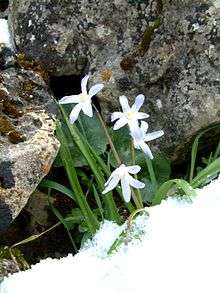Chionodoxa nana
| Chionodoxa nana | |
|---|---|
 | |
| Scientific classification | |
| Kingdom: | Plantae |
| Clade: | Angiosperms |
| Clade: | Monocots |
| Order: | Asparagales |
| Family: | Asparagaceae |
| Subfamily: | Scilloideae |
| Genus: | Chionodoxa |
| Species: | C. nana |
| Binomial name | |
| Chionodoxa nana (Schult. & Schult.f.) Boiss. & Heldr. | |
| Synonyms | |
| |
Chionodoxa nana or dwarf glory-of-the-snow is a bulbous perennial from Crete flowering in early spring with flowers in shades of lilac blue. After flowering, it goes into dormancy until the next spring.
Taxonomy
All Chionodoxa species are included in Scilla by some botanists, who do not consider the differences to be sufficient to create a separate genus.[1]
Plants occurring in Crete have at one time or another been put into one of three species: C. albescens (Speta) Rix, C. cretica Boiss. & Heldr. and C. nana (Schult. & Schult. f.) Boiss. & Heldr. Sfikas' Wild flowers of Crete recognizes only two of these (C. cretica and C. nana);[2] the Natural History Museum's checklist of the Cretan Flora recognizes only one (C. nana, as Scilla nana).[3]
Description
Like all members of the genus Chionodoxa, the bases of the stamens are flattened and closely clustered in the middle of the flower. In the related genus Scilla, the stamens are not flattened or clustered together.[4]
C. nana (including C. cretica) has two leaves per bulb, and at most one flowering stem, with one to five (more commonly three) flowers in a loose raceme. Individual flowers are up to 2.4 cm diameter with tepals up to 1.1 cm long, most facing upwards, the overall colour effect being some shade of lilac-blue.[5] Sfikas distinguishes between larger forms with bluer flowers occurring below 1700 m, C. cretica, and smaller forms with whitish flowers occurring above 1700 m, C. nana.[2]
C. nana subsp. albescens (synonym C. albescens) has slightly smaller flowers (tepals up to 1 cm long), whitish with lavender to violet-blue tips.[6] It was awarded the RHS Award of Garden Merit (H4 – hardy outdoors anywhere in the British Isles) in 2004, subject to availability.[7]
Notes and references
- ↑ Dashwood & Mathew 2005, p. 5
- 1 2 Sfikas 1987, p. 268
- ↑ Turland et al. 1993, p. 185
- ↑ Mathew 1987, p. 25
- ↑ Mathew 2005, p. 120
- ↑ Mathew 2005, p. 119
- ↑ Dashwood & Mathew 2005
Bibliography
- Beckett, Kenneth; Grey-Wilson, Christopher, eds. (1993), Alpine Garden Society Encyclopaedia of Alpines, Vol. 1 (A-K), Pershore, UK: AGS Publications, ISBN 978-0-900048-63-0
- Dashwood, Melanie & Mathew, Brian (2005), Hyacinthaceae – little blue bulbs (RHS Plant Trials and Awards, Bulletin Number 11), Royal Horticultural Society, archived from the original on 28 August 2015, retrieved 28 August 2015* Mathew, Brian (1987), The Smaller Bulbs, London: B T Batsford, ISBN 978-0-7134-4922-8
- Mathew, Brian (2005), "Hardy Hyacinthaceae, Part 2: Scilla, Chionodoxa, xChionoscilla", The Plantsman (New Series), 4 (2): 110–21
- Sfikas, George (1987), Wild Flowers of Crete, Athens: Efstathiadis, ISBN 978-960-226-052-4
- Turland, N.J.; Chilton, L.; Press, J.R & Natural History Museum (London) (1993), Flora of the Cretan Area: annotated checklist and atlas, London: HMSO, ISBN 978-0-11-310043-9